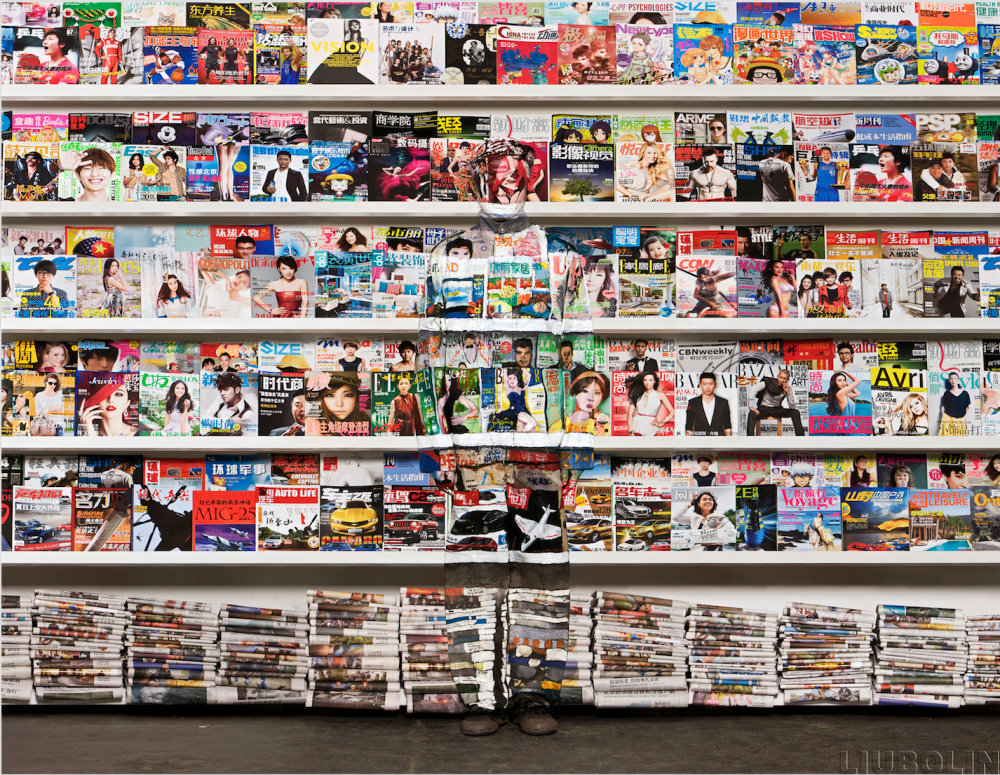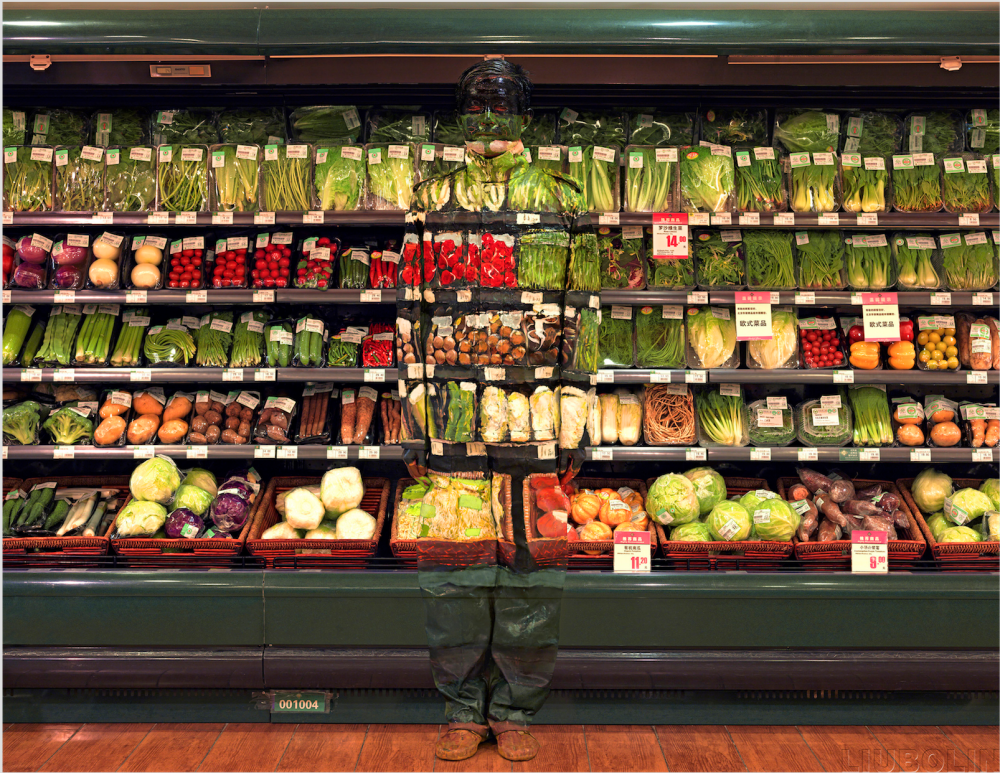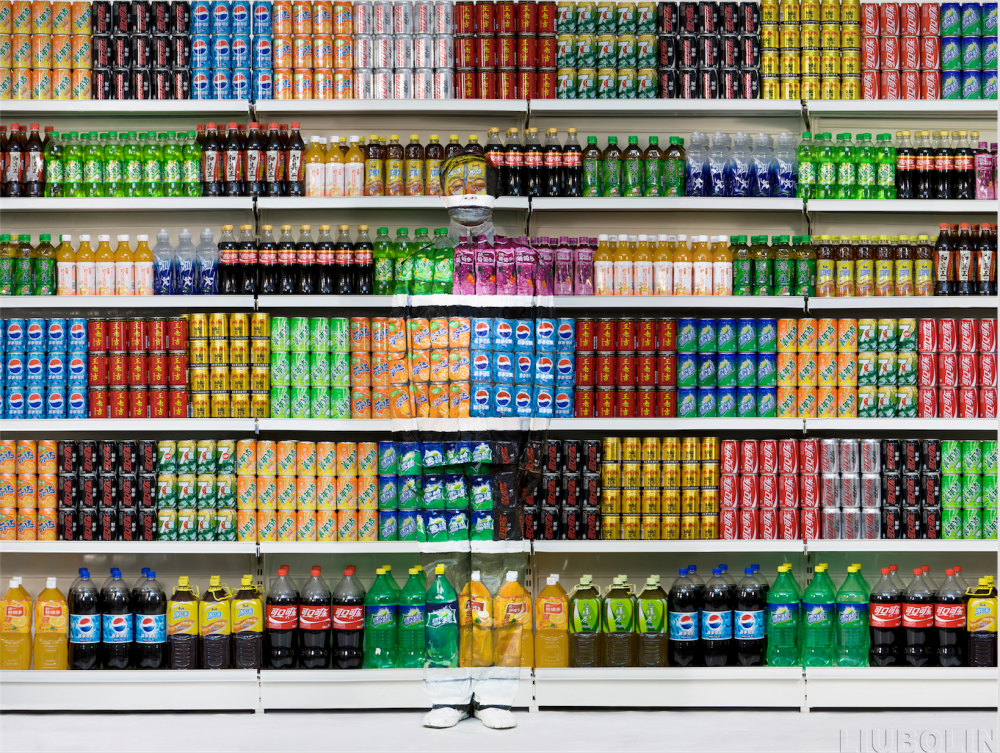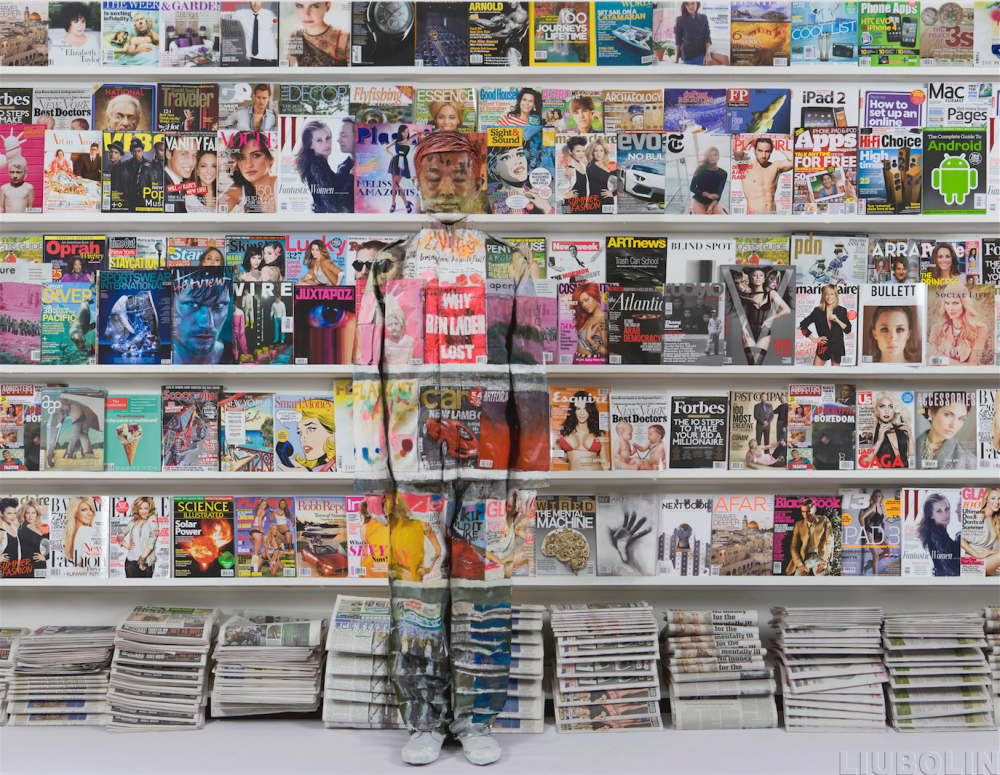MUSEE: What inspired your “hidden” series of photographs?
liU Bolin: At the end of 2005, I was living in Beijing and working as an artist’s assistant. Beijing’s art world at this time was thriving. All 140 artists in Suo Jia Cun were exclusively making art, and this is what I knew I wanted to do. On November 16, 2006 when Suo Jia Cun was forcibly demolished, I decided to use my works to make a stand against this atrocity. I wanted to show the state of artists in society, that their living and working places had not been protected.
The stillness of my body during the production of the work is a silent protest. The insistence of my body and its resistance to movement and nature are both reflected in my work. I’m fighting for free-dom and for the social status of the artist with my body.
M: How has your experience of urban environments changed as you have traveled across the globe?
lB: Starting in 2006, I have had many opportunities to exhibit my works globally, so every year I am able to participate in the foreign art world. My works have travelled from Asia, Europe, and North America, to South America, India, and the Middle East. Due to the global economic crisis and subsequent recov- ery during the times of my travels, I have experienced how cities change as the world economy changes. I travelled to London in 2008, and went back again this year. In comparing these two experiences, I feel that this city has gone through such a dramatic change after the London Olympics—the food for example. Of course, the whole social structure, culture, language and so on have transformed greatly; it really feels like we’re in a Global Village.
M: What motivated the incorporation of commodities into the series?
lB: That has actually been a theme for some time. From 2009, the “instant noodle” elements have started to appear in my Hiding in the City series. Beginning with that work, I have become more con- cerned with food safety issues. Before that time, I never considered that food that goes in your mouth could contain harmful additives. However, news stories regarding food issues broke out in the media in 2009, and in 2011, plasticizer was discovered in food. Now, there are even issues with genetically modified food. My solo exhibition in New York, A Colorful World? is in fact a reflection and criticism on food safety—it presents the threat that food safety problems impose on human lives and portrays my concern. I have a series of work in this exhibition that conjoins the packages of chemically altered food with human destruction, forming a contradiction. It is an attempt to visually present pop art that is also an expression of concern about the future of human fate.
 Image above: Liu Bolin, Hiding in the City Beijing - Magazine Rack. Image courtesy of the artist and Klein Sun Gallery.
Image above: Liu Bolin, Hiding in the City Beijing - Magazine Rack. Image courtesy of the artist and Klein Sun Gallery.
M: How long does it typically take to create one of your “hidden” photographs?
lB: After I have selected the background, I then consider the position in which I will stand, the direc- tion that I will face, the distance of the camera, and the best way to record this photograph. Once I have chosen the position of myself and of the camera, the composition of the work is fundamentally defined as well. At this time, I will converse with my assistants, on topics such as what color is the obstructed background, how to paint that obstructed background, how to paint in general, what am I looking for at the beginning of the process, what am I looking for as an end result, how to focus on the key point, how to make the process faster and better, how to make the color of the obstructed background emerge on my body, etc. After I have successfully finished communicating with my assistants, my task is to stand in the pre-selected position, without any movement. At that time, I am just a model, coordinating with my assistants as they try as adroitly as possible to complete the work.
To finish one work, it will take 3-4 hours.
M: Do you work with the same team of assistants when you travel?
lB: My studio is in Beijing. There I have assistants who help me complete my sculptures, paintings, and photography--including the painting on me for my Hiding in the City works, and also my new Target series. When I am shooting abroad, I recruit skilled artists from the local area to assist me with the painting aspect of the works of Hiding in the City. As for the photographer, I generally work with Zachary Bako, an American. We met four years ago in New York, and three years ago he came to China to help me photograph some works. He has helped me complete many of my works, including the ones in the Americas and in England.
 Image above: Liu Bolin, Hiding in the city - Vegetables, 2011. Image courtesy of the artist and Klein Sun Gallery.
Image above: Liu Bolin, Hiding in the city - Vegetables, 2011. Image courtesy of the artist and Klein Sun Gallery.
M: Your works disturb conventional figure-ground relationships. They are like trompe-l’oeil paintings in reverse. What does it feel like to blend into your environment? How is your experience looking at the final image different from your experience actually being on the street?
lB: As an artist, I will predict the visual effect of the final result of my work and my position in it when I am shooting. So far, however, there have been many instances when I look at the final product of my work, and I cannot find myself immediately. It is a very strange feeling. Whenever I am standing [during the process of my work], I keep communicating with my assistants to come up with the most effective and efficient way to complete the work because the longer it takes to create the work, the more physical energy I lose. Whenever I am physically enervated in a project, I rely on willpower to pull through and finish up the work, and this kind of dedication to art and the struggle in life will reflect in the work. As a result, my works all manifest a kind of devotion to art and to life.
M: What is the strangest thing that has happened during the construction of one of your photographs?
lB: I think the most interesting aspect is probably the change. Nobody understood my work when I started ten years ago. Gradually people began to understand the work and the ideas behind them. Now, many people want to participate in the making of my artworks. Looking at this from my point- of-view is really fascinating because the initial thought of my creation is to reflect my personal ideals onto humankind as a whole. Now that there are people from all over the world participating in the works of this series, it certainly corresponds to my original artistic intention and vision.
 Image above: Liu Bolin, Hiding in the city No. 96 - Supermarket No. 3, 2011. Image courtesy of the artist and Klein Sun Gallery.
Image above: Liu Bolin, Hiding in the city No. 96 - Supermarket No. 3, 2011. Image courtesy of the artist and Klein Sun Gallery.
M: What happens to the clothes that you wear after you take each photograph?
lB: At the beginning of the Hiding in the City series, I didn’t have much money. One set of the clothes was used to paint two or three works. After each photograph, I would keep the clothing. Now, I only use one set of clothes for each artwork. After the artwork is finished, I preserve the clothing. In my storehouse in Beijing, I have several large boxes to keep the clothes. I have taken many measures to prevent dampness and protect against insects. I think that if there is an opportunity in the future, I can hold a specialized exhibition of the clothing.
M: How did your collaboration with Bon Jovi come about?
lB: Our collaboration happened in the second half of 2012. My wife Shanna Sun and I have always enjoyed Bon Jovi’s music. At the time he happened to be releasing a new album, and he wanted me to create the album cover. That was how [his team] found the Klein Sun Gallery—the gallery that rep- resents me. The collaboration just naturally happened like that. For me, it was natural for us to work together because I am such a fan of his music—music that reflects a determined and defiant attitude toward destiny. Likewise, they are intrigued by the visual impact of my artworks.
M: Can you speak a little bit about your most recent, sculptural work?
lB: Currently I am showing several sculptural works in my A Colorful World? solo exhibition in New York. Sculpture is my artistic background, but I started creating works like Hiding in the City after the destruction of my art district ten years ago. It is a path that marries performance art and photog- raphy. However, I have never stopped exploring the possibilities with sculpture. Through the endless attempts in the direction of my Hiding in the City series, I realized that I tend to ruminate more about the things that are impertinent to the human life yet are harmful to human lives. My inspiration for sculptures have sprung from many different elements from the Hiding in the City series—such as the rubble of bricks from moving, genetically modified food packages, and magazines that shape human thoughts. Last year I thought of the conflict between the process of airport security checks and human lives. Incidentally there has been quite a number of flight accidents this year, resulting in hundreds and thousands of casualties. This affected me deeply, which is why I have chosen to employ the pose of raising both arms over the head, or the pose of the airline security check, in my sculpture. Such gesture that represents surrender is also a symbol of people’s struggle for survival in the world today. Mean- while the prints of food packaging on the surface of the sculptures convey the ideas of how food safety inflicts harm on human lives, and that ties in with the idea of prayers for survival. It demonstrates a conflict that would make viewers ponder about future fate and current issues
M: The theme of this issue is ritual. What are your daily rituals?
lB: I think everyone lives in some form of ritual. Your routine from the past will decide your present and future lifestyle and habits. In addition, I feel that everyone gets lost in habit, or gets dominated by his or her habit. Therefore, we must go beyond ourselves, jump out and see our strengths and faults in order to be in better control of our own fates. My current situation is to constantly change my pattern of thinking and also experiencing the world’s pattern of thinking, so as to be better at grasping the world, interpreting art, and expanding myself.
 Image above: Liu Bolin, Hiding in New York No. 3 - Magazine Rack, 2013. Image courtesy of the artist and Klein Sun Gallery.
Image above: Liu Bolin, Hiding in New York No. 3 - Magazine Rack, 2013. Image courtesy of the artist and Klein Sun Gallery.



